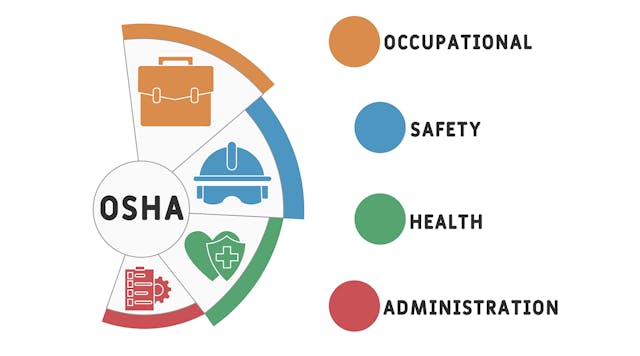Sleep is a fundamental pillar of health, and its importance in the workplace cannot be overstated. In this article, we’ll explore the prevalence of sleep deprivation among shift workers, the powerful connection between healthy sleep habits and employee performance, and practical tips on how you can improve your sleep hygiene. By arming EHS professionals with the knowledge and strategies they need, we can create a work environment where employees feel rested, can perform their duties safely and the full potential of the team is unlocked.
Let’s start by shining a light on the prevalence of sleep deprivation in the workplace. Industries that require round-the-clock operations face unique challenges when it comes to sleep deprivation. Irregular schedules and disruptions to the circadian rhythm can have a significant impact on the sleep quality of workers, putting them at a high risk of experiencing sleep-related issues, such as insomnia, in comparison to traditional daytime workers. Moreover, shift work is associated with chronically impaired cognition and increased risk of chronic disease. This alarming statistic underscores the need to address sleep-related challenges in the workplace to safeguard the well-being and safety of these employees.
Now, let's discover how to spot sleep deprivation among your employees. By recognizing the signs and symptoms of sleep deprivation, EHS professionals can truly move the needle in creating a healthier, safer work environment. Understanding the impact of sleep on employee performance, safety and overall well-being is essential. Look out for excessive fatigue, reduced alertness, difficulty concentrating, mood disturbances and a greater likelihood of making errors. When you notice these red flags, you can act quickly and intervene to support their well-being.
The good news is that the data shows that healthy sleep habits play an important role in employee performance. On the other hand, sleep deprivation can lead to decreased productivity, impaired judgment, slower reaction times and an increased risk of accidents.
EHS professionals can create safer work environments within their organizations by championing healthy sleep habits. By creating awareness about the benefits of good sleep and educating staff on sleep hygiene, EHS professionals can positively support employees’ sleep health.
An organization and its employees can be allies to promote healthy sleep habits. First, by understanding that more quality sleep can lead to more resilience, better concentration and memory, but also better mood and less mistakes at work. Second, by arranging flexible schedules and having a bright environment when possible. Just starting a conversation and asking how your employees are sleeping can be a good start.
Practical Strategies to Healthier Sleep Habits
Here are some practical strategies that organizations can implement to promote healthy sleep habits among shift workers:
Design comfortable rest areas and encourage their use: Employees can maximize their rest breaks in comfortable, sound-proof environments with dim lighting. Want to take it up a notch? Encourage them to close their eyes during their break if they feel fatigued or drowsy; some might even fall asleep for a few minutes, boosting their energy and decreasing drowsiness. When they need to be vigilant for work during evening or night shifts, ensure they have appropriate and bright lighting.
Support stress management: Be aware of your employees’ stress level. High levels of stress can significantly impact sleep quality (and sleep quality and quantity impact stress). One way to help manage stress in the organization is to encourage your employees to get enough sleep and to respond to their individual needs in that regard. If there’s a rush at work, sleeping less is very unlikely to help the organization or the individuals. Better sleep is an efficient tool to deal with stress and one that is accessible to everyone.
Be a game changer: Educate employees on the spectrum of benefits to prioritize sleep. Offer educational programs and resources that provide information on healthy sleep practices. Topics to cover may include maintaining a consistent sleep schedule, creating a sleep-friendly bedroom environment, practicing relaxation techniques before bed, limiting caffeine and electronic device use close to bedtime, the importance of winding down before sleep, and much more.
Implement Cognitive Behavioral Therapy for Insomnia programs: Consider incorporating Cognitive Behavioral Therapy for Insomnia (CBT-I) programs as an option to support employees in improving their sleep. CBT-I is recommended as the first line treatment for insomnia, according to the American Academy of Sleep Medicine. It involves techniques such as sleep restriction, stimulus control and cognitive restructuring to help individuals develop better sleep habits and manage sleep-related issues. By offering CBT-I programs, organizations can provide employees with effective tools and strategies to overcome sleep difficulties and improve their overall well-being.
Establish consistent schedules: Shift work disrupts circadian rhythms. Some employees are more flexible than others when it comes to changing schedules and sleep time. When possible, maintaining consistency in work schedules can help regulate employees’ sleep-wake cycles. If you can align the work schedule with your employee’s preferences (some are night owls and prefer working evenings and nights, while others perform better in the early morning), you are onto something. When employees’ schedules rotate over weeks, make sure to give them enough time to recuperate in-between different schedules.
Investing in sleep health is a strategic decision that directly impacts productivity, safety and the bottom line. Organizations that prioritize healthy sleep habits gain a competitive edge in today’s dynamic business landscape.
Sleep deprivation in the workplace poses significant risks to safety, productivity and employee well-being. Shift workers are particularly at risk of being sleep deprived. By learning how to optimize sleep in shift work situations and equipping EHS professionals with the necessary tools and knowledge, organizations can proactively address sleep-related challenges in their workforce.
Recognizing the unique needs of shift workers and implementing strategies to promote quality sleep will unlock the full potential of the workforce, leading to improved productivity and a safer work environment. This includes recognizing signs of drowsiness, allowing employees short nap breaks during evening and night shifts, and being flexible with the start and end times of shifts when possible. As EHS professionals take the lead in fostering a culture that values and prioritizes healthy sleep habits, organizations will reap the benefits of enhanced workplace productivity, safety and employee well-being.
Brad Smith is the founder and CEO of HALEO, a virtual sleep clinic. HALEO’s mission is to improve health and performance by increasing access to quality care for poor sleep. HALEO provides professional, clinically proven solutions for sleep disorders and is accessible through a mobile app.
Maude Bouchard, PhD, is a neuropsychologist and director of research and development with HALEO, with over a decade of experience in sleep science.
Philippe Stenstrom, PhD, is co-founder and scientific director of HALEO.
Resources
Boivin DB, Boudreau P. Impacts of shift work on sleep and circadian rhythms. Pathol Biol (Paris). 2014 Oct;62(5):292-301. doi: 10.1016/j.patbio.2014.08.001. Epub 2014 Sep 20. PMID: 25246026.
Folkard S, Tucker P. Shift work, safety and productivity. Occup Med (Lond). 2003 Mar;53(2):95-101. doi: 10.1093/occmed/kqg047. PMID: 12637593.
Kaneita Y, Ohida T. Association of current work and sleep situations with excessive daytime sleepiness and medical incidents among Japanese physicians. J Clin Sleep Med. 2011 Oct 15;7(5):512-22. doi: 10.5664/JCSM.1322. PMID: 22003348; PMCID: PMC3190852.
Lavie P. Sleep habits and sleep disturbances in industrial workers in Israel: main findings and some characteristics of workers complaining of excessive daytime sleepiness. Sleep. 1981;4(2):147-58. doi: 10.1093/sleep/4.2.147. PMID: 7256075.
Marquié JC, Tucker P, Folkard S, Gentil C, Ansiau D. Chronic effects of shift work on cognition: findings from the VISAT longitudinal study. Occup Environ Med. 2015 Apr;72(4):258-64. doi: 10.1136/oemed-2013-101993. Epub 2014 Nov 3. PMID: 25367246.
Ohayon MM, Lemoine P, Arnaud-Briant V, Dreyfus M. Prevalence and consequences of sleep disorders in a shift worker population. J Psychosom Res. 2002 Jul;53(1):577-83. doi: 10.1016/s0022-3999(02)00438-5. PMID: 12127174.
Pallesen S, Bjorvatn B, Waage S, Harris A, Sagoe D. Prevalence of Shift Work Disorder: A Systematic Review and Meta-Analysis. Front Psychol. 2021 Mar 23;12:638252. doi: 10.3389/fpsyg.2021.638252. PMID: 33833721; PMCID: PMC8021760.
Roenneberg T, Merrow M. The Circadian Clock and Human Health. Curr Biol. 2016 May 23;26(10):R432-43. doi: 10.1016/j.cub.2016.04.011. PMID: 27218855.










































































